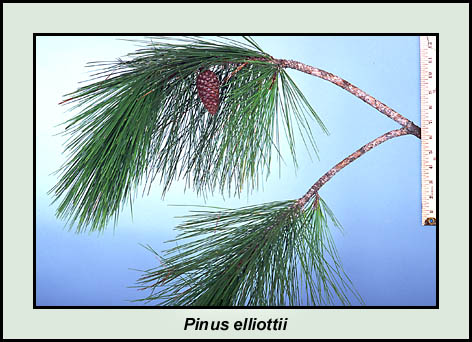Slash Pine
Pinus elliottii
Family: Pinaceae
Natural History

Needles and cone of slash pine | Photo credit: Larry Korhnak, University of Florida
Because of its rapid growth rate, slash pine is a valuable tree for reforestation projects and timber plantations throughout the southeastern United States. As a result, slash pines are currently planted, grown, and harvested over millions of acres. The trees take 30 years to reach sawtimber size (greater than nine inches in diameter). A good site can produce a well-stocked stand of about two cords of wood per acre per year.
There are two varieties of this tree species: slash pine (Pinus elliottii var. elliottii) and southern (or south Florida) slash pine (Pinus elliottii var. densa). The two varieties differ not only in geographical location, but also in seedling development and wood density. Southern slash pine is of denser wood and, unlike the slash pine, undergoes a grass stage.
Slash pine is a common associate of loblolly pine (Pinus taeda). The length and number of needles per fascicle, cones, and bark can be used to differentiate them. Slash pine has "brooms" of needles at the ends of rough twigs. Needles may be five to 11 inches long and are borne two to three per fascicle. Cones range from five to eight inches in length. Loblolly has three needles per fascicle that are six to 10 inches long. Loblolly cones are three to six inches long, but they are light reddish-brown and persist for three years of growth. Also, loblolly cones are far pricklier than slash pine cones. Bark of slash pine has large, flat, orange-brown plates. Loblolly bark is thick and divides into irregular, dark brown scaly blocks.
